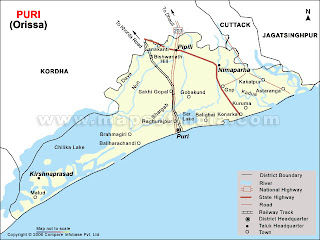The
glory and the history of ancient Odisha spanning from last 2000
Years. It was proud Kingdom of Kalinga. Kalinga was only state that
controlled most of the sea routes in Bay of Bengal.
For
many centuries, a substantial part of Southeast Asia, such as
Kampuchea (Cambodia), Java, Sumatra, Bali and Thailand were colonies
of Odisha.
As
a fact the name of the country "Siam" is derived from
Oriya/Sanskrit Shyamadesha.
The
temple of Angkor Wat is a fine example of Odisha's architecture, with
some local variations. Bali still retains the heritage of Odisha.
A
major turning point in world history took place in Odisha. The famous
Kalinga war that led emperor Ashoka to embrace non-violence and the
teachings of Buddha was fought here in 261 BC near the Daya River
which is often said that the whole river tured out to be red with
blood.
Later
on, Ashoka did recognized his fault and became a desiple of Gautam
Budha. Then at a later stage after getting the whole Gyan from
Gautam Budha he started preading Buddhist philosophy all over Asia
with his Son() and Daughter ().
In
the second century BC, Kalinga flourished as a powerful kingdom under
Kharavela. It is he who was built the superb monastic caves at
Udayagiri and Khandagiri.Subsequently, the kingdom was ruled under
various monarchs, such as Samudragupta and Sasanka. It also was a
part of Harsha's empire.
In
795 AD, the king Yayati united Kalinga, Kosala and Utkala into a
single empire. He also built the famous Jagannath temple at Puri.
King
Languda Narasimha Dev is reputed to have built the magnificent sun
temple in Konark. Although now largely in ruins, the temple would
easily have rivaled the Taj Mahal in splendor.
The
ruins of a major ancient university and center of Buddhist learning,
Ratnagiri, was recently discovered in Odisha. Scholars from far away
lands, such as Greece, Persia and China used to study philosophy,
astronomy, mathematics and science at this famed University.
Taxila,
Nalanda and Ratnagiri are the oldest universities in the world. The
ruins of Ratnagiri University have not been fully excavated yet.
During
the dark ages of Indian civilization, Odisha was ruled by a
succession of Muslim kings. It was later annexed by emperor Akbar and
became part of the Mughal empire.
After
the fall of the Mughals, the Marathas under Shivaji invaded the land
and continued to rule until 1803 AD when Odisha fell prey to the
barbaric British.
Modern
Odisha was carved out of Bihar in 1936. Contemporary Odisha has a
proud cultural heritage that arose due to the intermingling of three
great religious traditions - Hinduism, Buddhism and Jainism and later
on enriched by Islam and Christianity.






